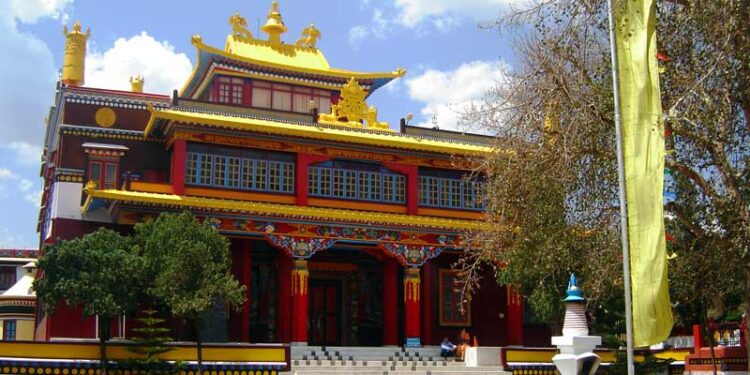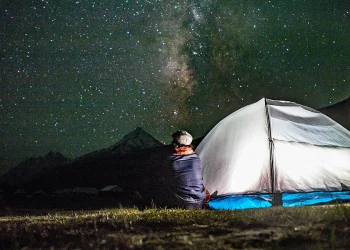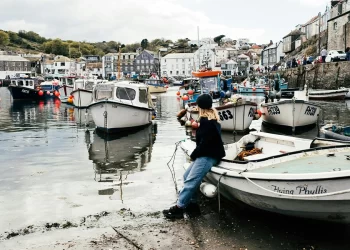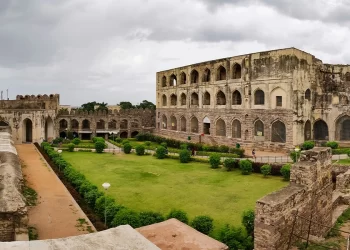(By Usha Bande) The deep blue of the sky is suddenly tinged with turmeric yellow and maroon, the tender spring foliage add a dash of green to it and make the colour combination cheerful against the backdrop of bleak hills. That is when you spot a monastery complex far off against the void of the valley and you know you are heading in the right direction. It is the famous Dolanji Bon Monastery near Solan that leaves you awe-struck by its exquisite beauty and peace.
Popularly known to the locals as the Buddhist temple, the Bon monastery is officially situated in Sirmour district of Himachal Pradesh but being nearer Solan, it is believed to be its part. Just 12 Kms from Solan town is Ochhghat, a small sleepy hamlet from where a road goes to Kheri; four kms from Kheri bifurcation is the monastery in Kotla Panjola village. You can get full view of the monastery from a distance but as the road winds and unwinds endlessly it takes another 15 minutes to reach the complex.
It is pretty, to say the least, peaceful and spotlessly clean. The main structure is delightfully painted in maroon, red, yellow and a dash of white and deep brown. The roof is typical Tibetan type and the slender prayer wheels on the sides lend it a purely Tibetan charm. The total ambience is of a mystical aura that can be felt but not described. The experience is one of tranquil perfection, its stillness profound, and its secrets intact in its vibrant colours.
Generally, Bon is thought to be a part of Buddhism but it is a separate and oldest spiritual tradition of Tibet. It is believed to have originated in the land of Olma Lungring, a part of the larger country called Tazig, located towards the west of Tibet. The founder of Bon was Tonpa Shenrab, and its followers came to be called Bonpo, meaning the followers of the Doctrine of Truth and Reality. When Indian Buddhism was being established in Tibet, many original elements of Bon traditions came to be integrated into it and vice versa. Thus Bon and Buddhism influenced one another and that is why both Tibetan Buddhism and Bon religion, though different in many ways, share identical ideological practices. The main aim of both is to bring an end to suffering. The Bonpos practice the teachings of their founder father Tonpa Shenrab that are collectively known as Yungdrung Bon, the “Tradition of Eternal Wisdom”. Historians believe that Bon is 18, 000+ years old and it derives from a deep respect for nature. Besides environmental harmony, its tenets work towards psychological contentment of man, medical therapies for physical well-being and pre-Buddhist spiritual inspiration.
The monastery at Kotla Panjola, near Solan was established in 1969. The first ‘Menri’ monastery was founded by Nyame Sherab Gyaltsen in Tsang (Tibet) in 1405 which was destroyed during the Cultural Revolution.
Later, in 1959 after Chinese occupation of Tibet many followers of Bon traditions left the country and settled in different parts of the world. Dozens of them came to establish a small camp near Solan. It was a tiny settlement of around 100 monks which has more than 350 residents at present.
The main monastery stands on a raised platform and is painted red and yellow with a huge entrance door that has beautiful decorative motifs. The two corner walls are decorated with colourful Tibetan religious motifs of dragons and other beings. Inside the huge prayer hall is the altar, the sacred water bowls and lamps and the prayer dais and rich Tankha paintings. The interior exudes peace and holy aura. The complex is well-planned with residential quarters, prayer wheels, a huge library and a school for the children: Yungdrung Bon Teaching and Listening Centre.
Far away in the valley one can see another complex come up. It has a nunnery — Redna Menling (Land of Precious Medicine) with a temple dedicated to a female goddess: Satrig Ersang (the Mother of All Beings). There is also the Central Tibetan School run by Govt of India.
Usually, the monastery hums with life with the teachings, the rituals, chanting, meditation, debates and the silence of nature. It is a unique and wonderful experience. But since life in the monastery is governed by strict rules, the monks are reserved or rather indifferent; it is difficult to take out information from them. Language problem may be another reason for their reticence.
It is this melange of exotic cults, spiritual people and rural ambience that makes a visit to the complex a unique experience. One would like to linger a little longer and spend a few more tranquil hours at this spot. Since the complex is on a high hill surrounded by valleys one can hear the seamless sibilant song of the winds. It whispers of travellers from faraway and long ago, lured to this peaceful valley. It murmurs of a land in which history blends effortlessly with myth. One could muse on the contradictions and complexities that have made the place enigmatic and irresistible.
TRAVEL INFO
Location: Dolanji Bon Monsatic Centre, Kotla Panjola, Occhghat, Solan.
Phone: 1799-253003-04.
How to reach: from Delhi/Chandigarh reach Kalka by rail or bus and from there to Solan by toy train or bus. Taxis are available from Solan at reasonable rates.
Distance from Solan: About 16 kms.
Weather: Hot in summers, cold in winter. It does not snow here.
Where to stay: The monastery has a five-storey Guest House with good facilities for lodging and boarding at modest rates. Other choice is staying in Solan.

Founded in 2016, The Traveller Trails is a print and digital magazine and a trusted source for current news, trends, analysis, opinions, interesting blogs, videos and exclusive interviews from every corner of the world.








